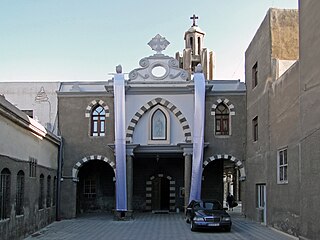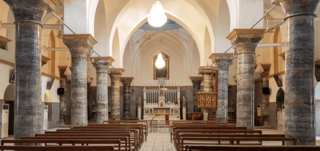
The Syriac Catholic Church is an Eastern Catholic Christian jurisdiction originating in the Levant that uses the West Syriac Rite liturgy and has many practices and rites in common with the Syriac Orthodox Church. Being one of the twenty-three Eastern Catholic Churches, the Syriac Catholic Church is a self-governed sui iuris particular church, while it is in full communion with the Holy See and with the entirety of the Catholic Church.

An exarch was the holder of any of various historical offices, some of them being political or military and others being ecclesiastical.

The Chaldean Catholic Church is an Eastern Catholic particular church in full communion with the Holy See and the rest of the Catholic Church, and is headed by the Chaldean Patriarchate. Employing in its liturgy the East Syriac Rite in the Syriac language, it is part of Syriac Christianity. Headquartered in the Cathedral of Our Lady of Sorrows, Baghdad, Iraq, since 1950, it is headed by the Catholicos-Patriarch Louis Raphaël I Sako. In 2010, it had a membership of 490,371, of whom 310,235 (63.27%) lived in the Middle East.
The Chaldean Catholic Archeparchy of Kirkuk is an archeparchy of the Chaldean Catholic Church in communion with the Pope in Rome. The archeparchy was created in the early years of the nineteenth century. Its present ordinary, Archbishop Yousif Thomas Mirkis, was consecrated in 2014.
The Chaldean diocese of Gazarta, named for the town of Jezira, known in Syriac as Gazarta d'Beth Zabdai, was established on a stable basis in the early nineteenth century. Many of the Assyrians of the Gazarta region, including the bishop of Gazarta Pilipus Yaqub Orahim, were killed during the Assyrian genocide during 1914-1918. On 3 July 1957, it was suppressed and its territory divided between the Chaldean Catholic Diocese of Diarbekir (Amida), the Chaldean Catholic Diocese of Aleppo and the newly established Chaldean Catholic Diocese of Beirut.
The Syriac Catholic Eparchy of Our Lady of Deliverance is a Syriac Catholic Church ecclesiastical territory or eparchy of the Catholic Church in the United States. The territory of the eparchy encompasses the entire United States. Its cathedral is St. Joseph Syriac Catholic Cathedral, in Bayonne, New Jersey, near the episcopal see of Newark. Yousif Benham Habash has led the eparchy since April 2010.
This is a historical list of all bishops of the Catholic Church whose sees were within the present-day boundaries of the United States, with links to the bishops who consecrated them. It includes only members of the United States Conference of Catholic Bishops and their predecessors.
The Apostolic Vicariate of Beirut is a Latin Church ecclesiastical jurisdiction or apostolic vicariate of the Catholic Church in Lebanon, where Eastern Catholics are far more numerous. In 2010, there were 15,000 baptized. Its current bishop is Cesar Essayan.
The Chaldean Catholic Eparchy of Aqra is an Eastern Catholic eparchy (diocese) of the Chaldean Catholic Church in northern Iraq.
The Maronite Eparchy of Latakia or Latakia of the Maronites is a Maronite Church ecclesiastical territory or eparchy of the Catholic Church in Syria. As of 2011, there were 35,000 members. The current eparch is Antoine Chbeir.
The Chaldean Catholic Eparchy of Beirut is the sole eparchy of the Chaldean Catholic Church for all Lebanon.

The Chaldean Catholic Eparchy of Mar Addai of Toronto is the sole eparchy of the Chaldean Catholic Church in Canada.
The Syriac Catholic Archeparchy of Aleppo is a Syriac Catholic Church ecclesiastical territory or archeparchy of the Catholic Church in Syria. The Archeparchy of Aleppo is not a metropolitan see and is exemption directly to the Syriac Catholic Patriarch of Antioch.

The Armenian Catholic Eparchy of Alexandria (or Iskanderiya) is a suffragan eparchy (Eastern Catholicdiocese) of the Armenian Catholic Church sui iuris (Armenian Rite in Armenian language), in the Patriarch's own 'ecclesiastical province of Cilicia' (actually based in Beirut, Lebanon), covering Egypt and Sudan.
The Armenian Catholic Eparchy of Qamishli is a suffragan eparchy of the Armenian Catholic Church sui iuris in the Patriarch's own ecclesiastical province 'of Cilicia', serving part of Syria.
The Armenian Catholic Archeparchy of Aleppo (or Halab or Beroea) (informally Aleppo if the Armenians) is a non-Metropolitan Archeparchy (Eastern Catholic Archdiocese) of the Armenian Catholic Church sui iuris (Armenian Rite in Armenian language) in part of Syria.

The Syriac Catholic Patriarchal Eparchy of Beirut is a Syriac Catholic Church ecclesiastical territory or eparchy of the Catholic Church in Lebanon. The Syriac Catholic Patriarch of Antioch's cathedra is found in the eparchy in the episcopal see of Beirut, the capital of Lebanon.
The Armenian Catholic Eparchy of Sainte-Croix-de-Paris is an eparchy for the faithful in France of the Armenian Catholic Church sui iuris, which uses the Armenian Rite in Armenian, in full communion with the universal Pope of Rome.

The Ordinariate for Eastern (Rite) Catholics in France is a Catholic Ordinariate for Eastern Catholic faithful, jointly for Eastern Catholics in various rites and languages of particular churches sui iuris without proper jurisdiction there.








